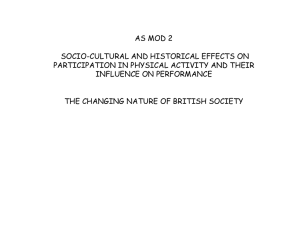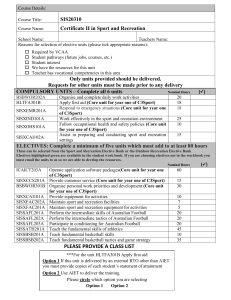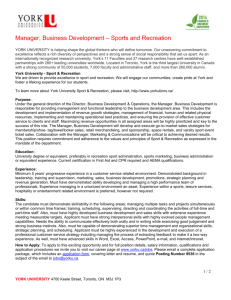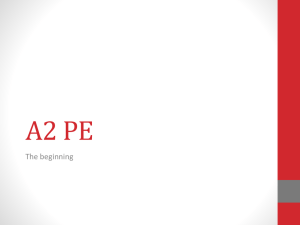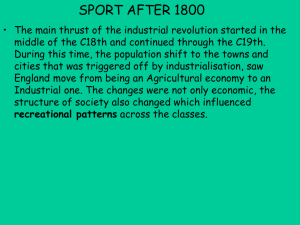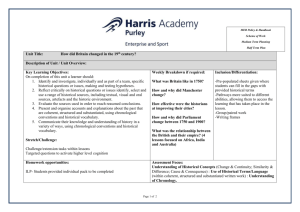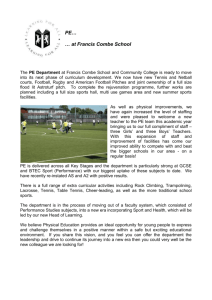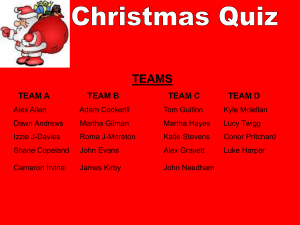19th C Britain
advertisement
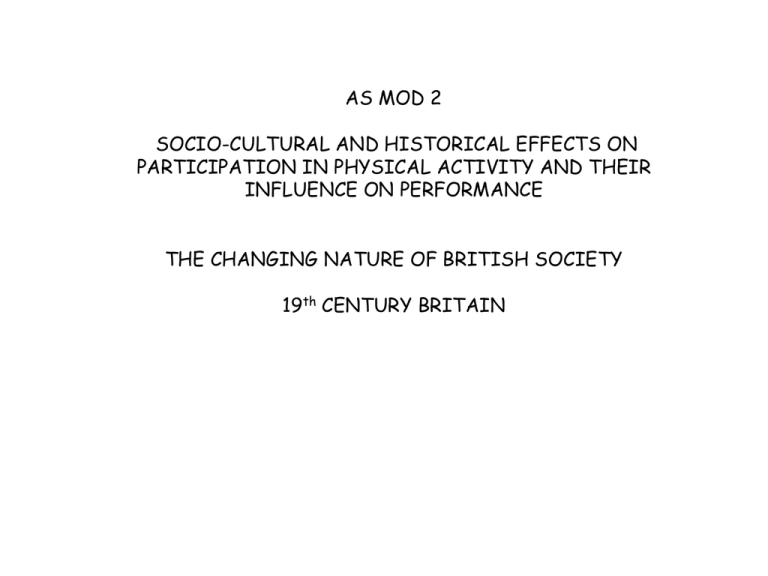
AS MOD 2 SOCIO-CULTURAL AND HISTORICAL EFFECTS ON PARTICIPATION IN PHYSICAL ACTIVITY AND THEIR INFLUENCE ON PERFORMANCE THE CHANGING NATURE OF BRITISH SOCIETY 19th CENTURY BRITAIN The Changing Nature of British Society Introduction: Sport is an INTEGRAL part of society British Society has undergone 3 phases 1. 2. 3. Pre-industrial society Industrialisation Post Industrial/Advanced Technological Society Developments in sport tend to MIRROR developments in society For example As society became CIVILISED so did sporting recreations of the time as reflected in the development of RULES, SKILLS and ETIQUETTE for many games What does Industrialisation mean? Process in 18th and 19th C when Britain moved from predominantly AGRICULTURAL base to an ECONOMY dominated by MANUFACTURING What does the CIVILISING OF SOCIETY mean? The development of HUMAN MANNERS, e.g the practicing of SELF RESTRAINT in social situations. CODES of BEHAVIOUR and ETIQUETTE became the norm. Sports became LESS VIOLENT in nature The birth of MODERN SPORT began in BRITAIN, the 1st INDUSTRIALISED country in the WORLD Modern sport developed in an atmosphere where social and economic conditions occurred, these were: 1.) Industrialisation 2.) Effective communications 3.) URBANISATION (mass of population changes lifestyle from living in villages/rural areas to living in towns/cities) 4.) Affluent society 5.) Population with sufficient leisure time and surplus disposable income PRE-INDUSTRIAL BRITAIN (pre 1750) - Majority of population lived in RURAL areas working on the land - UPPER CLASSES Were wealthy landowners holding political power - WORKING CLASSES Had little free time and their lives were harsh Strong sense of community Lack of free time = recreations only took place occasionally and mostly on RELIGIOUS HOLIDAYS and FESTIVALS As participation was not regular, many activities DID NOT develop STRUCTURALLY but retained their TRADITIONAL nature over 100’s of years = POPULAR RECREATION (eg MOB FOOTBALL) Peasants were UNEDUCATED (compulsory schooling >1870), whereas Upper Classes were educated in elite PUBLIC SCHOOLS In groups What were the characteristics of POPULAR RECREATION (eg MOB FOOTBALL)? - occasional due to free time - only a few simple unwritten rules - activity being PARTICIPATION-BASED rather than SPECTATOR-BASED - physical force rather than skill - many injuries/violent - lower class involvement - LOCAL rather than REGIONAL or NATIONAL events - limited STRUCTURE , EQUIPMENT and FACILITIES 19th CENTURY BRITAIN When Queen Victoria was on the throne This era saw major transition in society Immense contrasts between RICH and POOR Nation was PROSPEROUS and STABLE This era coincided with the INDUSTRIAL REVOLUTION The Industrial Revolution (1750 – 1850): Nation underwent URBANISATION Cramped living and working conditions in towns Move from AGRICULTURE and COTTAGE (craft workshops) industries to FACTORIES Britain seen as WORKSHOP OF THE WORLD Industrial Revolution c’ntd Britain was 1st European Country to undergo Industrial Revolution By middle of 19th C, Britain was WORLD’S LEADING INDUSTRIAL POWER By 1901: only 10% of its labour force worked in agriculture ¾ of population lived in TOWNS/CITIES population nearly TREBLED In pairs: How would this have affected the working week, recreation, environment? - Hours being worked (12 hrs/day) - Women and children working (coal industries) - Working week (6 days) - Expectations to attend church on Sun - Little time for rest and leisure (no MOB FOOTBALL) - Restricted recreational opportunities/facilities - Urban squalor (poor health) - Spoiled landscapes Industrial Revolution c’ntd Gradually improvements were made: - Trade Unions helped - ½ day Saturdays - Early closing for shop workers on Wed - Bank Holiday’s (provision of NATIONALLY recognised LEISURE TIME) - Wages increased giving working classes DISPOSABLE income In pairs: How were these new working conditions positive for Sport and Recreation? - participation in more activities - Spectator sports and facilities began to develop - Increased disposable income meant more money to spend on leisure - On Bank Holidays, people began taking excursions to the country/seaside by train/cycling/foot - Town and City parks were used for recreational purposes TECHNOLOGICAL ADVANCES IN 19th CENTURY BRITAIN - In 19th C scientific and industrial invention thrived - Edison invented electric light bulb and improved telegraph, telephone and motion picture projector In Pairs: How did technological advances affect sport and recreation? - Sports were being invented e.g rugby, football, lawn tennis, basketball and volleyball - Sports equipment was being invented e.g lawn tennis kits, improvement in golf equipment (priced it out of working classes) - Steam press enabled cheaper production of newspapers (interest in sport bloomed) - Invention of bicycle - cheaper transport - accepted leisure pursuit for ladies - More practical clothing designed TRANSPORT IN 19th CENTURY BRITAIN -Transport began with rivers (many early towns built next to waterways) - Aquatic activities (eg rowing, swimming) began as functional activities - Roads accommodated horse and carting and later cycling - Railway enabled goods, people and ideas to be transported nationally/internationally In pairs: How did transportation advances affect the development of sport and recreation? - Railway encouraged popularity of excursions - Work holidays established seaside resorts, re-creating community spirit of pre-industrialisation (eg Blackpool) - OAA (eg rambling, fishing, cycling, mountaineering) boosted by rail access to isolated areas - Football fixtures could happen further afield (eg home and away tradition) RATIONAL RECREATION IN 19th CENTURY BRITAIN - POPULAR RECREATIONS unable to survive in new CIVILISED ENVIRONMENT - Cramped living conditions = lack of SPACE (mob football) - Middle/Upper classes required DISCIPLINED/PRODUCTIVE workers (suppress excessive behaviour) - Preventing recreations eg mob games and cock fighting - Increase in SOCIAL REFORM (eg working conditions improved, recreational facilities such as parks and baths provided What are the characteristics of Rational Recreation? - Regular participation - Complex written rules - Highly structured in nature - Being spectator-based as well as participation-based - The need to use refined skills instead of force - Being a middle to upper class development - Being regionally and nationally based - The use of sophisticated equipment and facilities How did SOCIAL REFORM affect sport and recreation? - Provision of parks to - improve health of population - discourage crime - attract people away from alcohol - encourage workers to participate in rational and rule governed behaviour - Working men’s clubs/institutes/Friendly societies/libraries established to further education of working classes THE CHURCH IN 19th CENTURY BRITAIN - As sports were becoming RATIONALISED, church could support their CIVILISED and MORAL qualities - Youth movements encouraged eg Boy’s Brigade, Scouts and Sunday School Teams (militaristic) - Church halls for recreation - MUSCULAR CHRISTIANITY (Charles Kingsley) believed in combination of CHRISTIAN and CHIVALRIC ideals of manliness (healthy bodies healthy minds to serve God) - YMCA aimed to develop high Christian standards through group activities and improve spiritual, social and recreational life of young people (using sport to achieve its aim) MIDDLE CLASS IN 19th CENTURY BRITAIN - Middle class emerged as a result of the INDUSTRIAL revolution (below aristocracy, but above workers - Tried to disassociate themselves form working class - Were religious/moralising and wanted to formulate activities of their own (that would benefit society) - Believed rational recreations could stabilise and transform society - Cricket, football and rugby were organised into National competitions eg FA cup - Invented LAWN TENNIS as a substitute for REAL TENNIS - Became ADMINISTRATORS of sport due to their organisational skills (est Clubs and Governing Bodies) - With their accumulated wealth they bought land and built facilities (eg Wimbledon Lawn Tennis and Croquet Club) 19th CENTURY MALE AND FEMALE ROLES - In Industrial era FEMALE role was in PRIVATE sphere and MALE role in PUBLIC sphere (business, commerce, politics) - Middle class women expected to work for service of others eg visiting the sick and needy. Were encouraged to demand more physical forms of recreation. - GIRL’S PUBLIC SCHOOLS copied BOY’s schools in academic and sporting terms - Hockey, netball and tennis were acceptable due to dress codes, rules, and could be played in privacy of school, club or garden - Working class women had least sporting/recreation opportunities (domestic role, no free time) - Working class women were poor, little political power and limited education AMATEURISM Based on ideal that participation in sport is for the LOVE of it rather than MONETARY GAIN PROFESSIONAL SPORT A sporting activity that is engaged in for FINANCIAL Gain or as a means of LIVELIHOOD Q.) Give an example of an EARLY professional sportsman? What are the similarities between a professional footballer today
